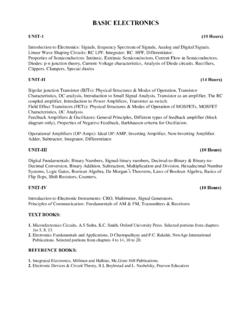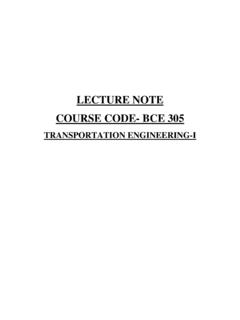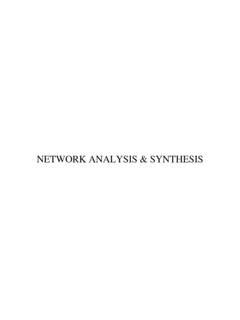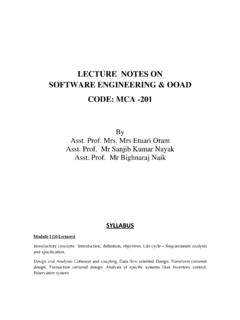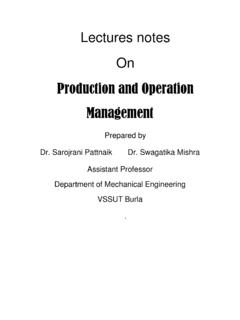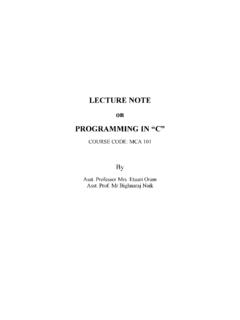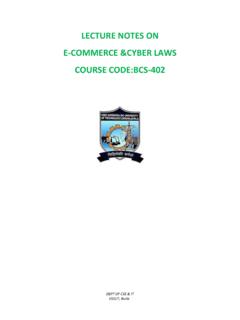Transcription of LECTURE NOTES ON SUB: INTERNAL COMBUSTION ENGINE …
1 LECTURE NOTES . ON. SUB: INTERNAL COMBUSTION ENGINE &. GAS TURBINES. 8th SEMESTER, MECHANICAL ENGINEERING. COURSE CODE BME 423. Prepared by: Mrs. Dulari Hansdah Assistant Professor DEPARTMENT OF MECHANICAL ENGINEERING. VEER SURENDRA SAI UNIVERSITY OF. TECHNOLOGY, BURLA, ODISHA. DISCLAIMER. This document does not claim any originality and cannot be used as a substitute for prescribed text books. The information presented here is merely a collection by the committee members for their respective teaching assignments. Various sources as mentioned at the reference of the document as well as freely available material from internet were consulted for preparing this document. The ownership of the information lies with the respective authors or institutions.
2 Further, this document is not intended to be used for commercial purpose and the committee members are not accountable for any issues, legal or otherwise, arising out of use of this document. The committee members make no representations or warranties with respect to the accuracy or completeness of the contents of this document and specifically disclaim any implied warranties of merchantability or fitness for a particular purpose. The committee members shall be liable for any loss of profit or any other commercial damages, including but not limited to special, incidental, consequential, or other damages. SYLLABUS. module - I. 1. introduction : Classification of IC engines, working cycles, comparison of two stroke & four stroke engines, Comparison between SI & CI engines.
3 (2). 2. Fuel COMBUSTION &Fuel injection: Structure & composition of IC ENGINE fuel, Fuel rating properties of fuel, Fuel additives and non-petroleum fuels. Fuel air requirement for ideal normal operation, maximum power & quick acceleration, simple carburetor & its draw back. Practical carburetor, petrol injection. Requirements & type of diesel injection system, fuel pump, injectors &nozzles.(8). module - II. 3. Ignition & COMBUSTION in IC Engines: Battery, magneto & Electronic ignition systems, Ignition timing, spark advance mechanism. Stages of SI ENGINE COMBUSTION , Effect of ENGINE variables on ignition lag flame front propagation. Abnormal COMBUSTION , pre- ignition & detonation, Theory of detonation, Effect of ENGINE variables on detonation, Control of detonation.
4 Requirement of good COMBUSTION chambers for SI engines. Stages of CI ENGINE COMBUSTION . Effect of ENGINE variables on delay periods. Diesel Knock & methods of control in CI ENGINE COMBUSTION chambers.(10). module - III. 4. Testing and performance: Power, Fuel and air measurement methods, performance of SI and CI Engines, Characteristics curve. Variables affecting performance and methods to improve ENGINE performance.(5). 5. Cooling and Lubricating Systems, ENGINE Emission & Controls: Air cooling and Water cooling system, Effect of cooling on power output & efficiency, properties of lubricants &types of lubricating system ENGINE emission & its harmful effect. Methods of measuring pollutants and control of ENGINE emission.(7). module IV.
5 6. Gas turbines: introduction , open & closed cycle gas turbines, Constant volume &constant pressure cycles. Thermodynamic analysis of ideal basic cycle with regeneration reheat & intercooling .Analysis of ideal basic cycle considering actual losses. Application of gas turbine.(8). LESSON PLAN. Sl. LECTURE Topics to be covered No. No. LECTURE -01 What is IC engines and components of IC ENGINE , IC ENGINE terminology, classification of IC engines, comparison of Two stroke &four stroke 1. engines, Comparison between SI & CI engines, valve and port timing diagram 2 LECTURE -02 Working cycles-Otto, Diesel and Dual cycle, problem solving LECTURE -03 Fuel- structure & composition of IC ENGINE fuel, properties of SI and CI. 3. ENGINE fuel, fuel rating 4 LECTURE -04 Fuel additives and non-petroleum fuels (alternative fuels).
6 LECTURE -05 Fuel air requirement for ideal normal operation, maximum power & quick 5. acceleration, simple carburettor and its parts, problem solving 6 LECTURE -06 Drawback of simple carburettor, types of carburettor LECTURE -07 Petrol injection, Lucas petrol injection system, electronic petrol injection 7. system 8 LECTURE -08 Requirements & type of diesel injection system 9 LECTURE -09 fuel pump, types of injectors 10 LECTURE -10 Types of nozzles, spray formation and its direction, injection timing LECTURE -11 Ignition system- requirements of ignition system, Battery and magneto 11. ignition system 12 LECTURE -12 Ignition timing, spark plug, spark advance mechanism 13 LECTURE -13 Disadvantage of conventional ignition system, electronic ignition system LECTURE -14 Factors affecting energy requirement of ignition system 14.
7 LECTURE -15 Stages of SI ENGINE COMBUSTION , effect of ENGINE variables on ignition lag 15. flame front propagation LECTURE -16 Abnormal COMBUSTION , pre-ignition & detonation, theory of detonation, effect 16. of ENGINE variables on detonation LECTURE -17 Control of detonation, requirement of good COMBUSTION chambers for SI. 17. engines 18 LECTURE -18 Stages of CI ENGINE COMBUSTION , effect of ENGINE variables on delay periods 19 LECTURE -19 Diesel Knock & methods of control in CI. 20 LECTURE -20 Diesel ENGINE COMBUSTION chambers LECTURE -21 Testing and performance- Indicated power (indicator diagram-piston 21. indicator, balanced-diaphragm type of indicator). Measurement of brake power (prony brake, rope brake, eddy current, 22 LECTURE -22 hydraulic dynamometer), Measurement of friction power (Willian s line method, Morse test, Motoring test).
8 LECTURE -23 Fuel consumption measurements (volumetric and gravimetric method), air 23. consumption measurements 24 LECTURE -24 Variables affecting performance of SI ENGINE 25 LECTURE -25 Variables affecting performance of CI ENGINE , problem solving LECTURE -26 ENGINE emissions, measurement method of smoke emission, measurement of 26. unburnt hydrocarbon emission 27 LECTURE 27 Measurement of CO2, NOx, ENGINE emission control 28 LECTURE 28 Requirement of cooling of the ENGINE , types of cooling, air cooling system 29 LECTURE 29 Water cooling (thermo-syphon, forced or pump, evaporative cooling system). LECTURE 30 Comparison of cooling system, Effect of cooling on power output &. 30. efficiency LECTURE 31 Lubrication- requirement of lubrication of the ENGINE , effect of variables on 31 ENGINE friction, principle and function of lubricating system, properties of lubricating oil 32 LECTURE 32 Types of lubricating system, additives to lubricating oil LECTURE 33 Turbine definition, types of turbines, comparison of gas turbine with 33.
9 Reciprocating IC ENGINE and steam turbine, classification of gas turbine 34 LECTURE -34 Thermodynamic cycle or Brayton cycle, problem solving 35 LECTURE 35 Regenerative gas turbine cycle, reheat gas turbine cycle, problem solving 36 LECTURE 36 Gas turbine cycle with both reheat and heat exchange method, gas turbine with inter cooler, problem solving 37 LECTURE 37 Real gas turbine, losses calculation, problem solving 38 LECTURE 38 Linking components of turbine, COMBUSTION chamber 39 LECTURE 39 Fuels for turbine, emission from turbine 40 LECTURE 40 Application of gas turbine, automotive gas turbine INTERNAL COMBUSTION ENGINE & GAS TURBINES. module - I. introduction . Heat ENGINE : A heat ENGINE is a device which transforms the chemical energy of a fuel into thermal energy and uses this energy to produce mechanical work.
10 It is classified into two types- (a) External COMBUSTION ENGINE (b) INTERNAL COMBUSTION ENGINE External COMBUSTION ENGINE : In this ENGINE , the products of COMBUSTION of air and fuel transfer heat to a second fluid which is the working fluid of the cycle. Examples: *In the steam ENGINE or a steam turbine plant, the heat of COMBUSTION is employed to generate steam which is used in a piston ENGINE (reciprocating type ENGINE ) or a turbine (rotary type ENGINE ) for useful work. *In a closed cycle gas turbine, the heat of COMBUSTION in an external furnace is transferred to gas, usually air which the working fluid of the cycle. INTERNAL COMBUSTION ENGINE : In this ENGINE , the COMBUSTION of air and fuels take place inside the cylinder and are used as the direct motive force.
